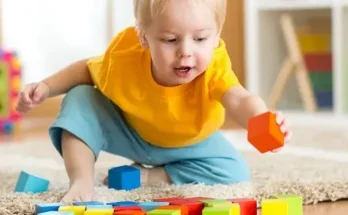Your child can begin eating solid foods at about 6 months old. By the time he or she is 7 or 8 months old, your child can eat a variety of foods from different food groups. These foods include infant cereals, meat or other proteins, fruits, vegetables, grains, yogurts and cheeses, and more.

Many health agencies and healthcare professionals recommend breastfeeding babies for the first 6 months. During this time, breast milk or formula is the only food your newborn needs.
But by ages 4 months to 6 months, most babies are ready to have solid foods added to their diet of breast milk or formula.
During this time most babies stop using their tongues to push food out of their mouths. Instead they use their tongues to move food from the front of the mouth to the back to swallow it.
Besides age, other signs that babies are ready for solid foods include being able to:
- Hold their heads up.
- Sit with little support.
- Bring their hands or toys to their mouths.
- Show they want food by leaning toward the food and opening their mouths wide.
- Show when they’re full by leaning back and turning away.
If your baby can do these things and your baby’s healthcare professional agrees, you can begin adding solid food to your baby’s liquid diet.
How to feed baby?
Start with half a spoonful or less and talk to your baby through the process (“Mmm, see how good this is?”). Your baby may not know what to do at first. They may look confused, wrinkle their nose, roll the food around inside their mouth or reject it altogether.
One way to make eating solids for the first time easier is to give your baby a little breast milk, formula or both first; then switch to very small half-spoonfuls of food; and finish with more breast milk or formula. This will prevent your baby from getting frustrated when they are very hungry.
Do not be surprised if most of the first few solid-food feedings wind up on your baby’s face, hands and bib. Increase the amount of food gradually, with just a teaspoonful or two to start. This allows your baby time to learn how to swallow solids.

If your baby cries or turns away when you feed them, do not make them eat. Go back to breastfeeding or bottle-feeding exclusively for a time before trying again. Remember that starting solid foods is a gradual process; at first, your baby will still be getting most of their nutrition from breast milk, formula or both. Also, each baby is different, so readiness to start solid foods will vary.
When can I give my baby finger foods?
Once your baby can sit up and bring their hands or other objects to their mouth, you can give them finger foods to help them learn to feed themselves. To prevent choking, make sure anything you give your baby is soft, easy to swallow, and cut into small pieces. Some examples include small pieces of banana, wafer-type cookies or crackers; scrambled eggs; well-cooked pasta; well-cooked, finely chopped chicken; and well-cooked, cut-up potatoes or peas.
At each of your baby’s daily meals, they should be eating about 4 ounces, or the amount in one small jar of strained baby food. Limit giving your baby processed foods that are made for adults and older children. These foods often contain more salt and other preservatives.
If you want to give your baby fresh food, use a blender or food processor, or just mash softer foods with a fork. All fresh foods should be cooked with no added salt or seasoning. Although you can feed your baby raw bananas (mashed), most other fruits and vegetables should be cooked until they are soft. Refrigerate any food you do not use, and look for any signs of spoilage before giving it to your baby. Fresh foods are not bacteria-free, so they will spoil more quickly than food from a can or jar.
NOTE: Do not give your baby any food that requires chewing at this age, or any food that can be a choking hazard. Foods to avoid include hot dogs (including meat sticks, or baby food “hot dogs”); nuts and seeds; chunks of meat or cheese; whole grapes; popcorn; chunks of peanut butter; raw vegetables; fruit chunks, such as apple chunks; and hard, gooey, or sticky candy.
What changes can I expect after my baby starts solids?
When your baby starts eating solid foods, their stools will become more solid and variable in color. Because of the added sugars and fats, they will have a much stronger odor, too. Peas and other green vegetables may turn the stool a deep-green color; beets may make it red. (Beets sometimes make urine red as well.)
If your baby’s meals are not strained, their stools may contain undigested pieces of food, especially hulls of peas or corn, and the skin of tomatoes or other vegetables. All of this is normal. Your baby’s digestive system is still immature and needs time before it can fully process these new foods. If the stools are extremely loose, watery, or full of mucus, however, it may mean the digestive tract is irritated. In this case, reduce the amount of solids and introduce them more slowly. If the stools continue to be loose, watery, or full of mucus, talk with your child’s doctor to find the reason.
Should I give my baby juice?
Babies do not need juice. Babies younger than 12 months should not be given juice. After 12 months of age (up to 3 years of age), give only 100% fruit juice and no more than 4 ounces a day. Offer it only in a cup, not in a bottle. To help prevent tooth decay, do not put your child to bed with a bottle. If you do, make sure it contains only water. Juice reduces the appetite for other, more nutritious, foods, including breast milk, formula, or both. Too much juice can also cause diaper rash, diarrhea or excessive weight gain.
Does my baby need water?
Healthy babies do not need extra water. Breast milk, formula, or both provide all the fluids they need. However, it is OK to offer a little water when you begin to give your baby solid foods. Use an open, sippy or strawed cup and limit water to no more than 1 cup (8 ounces) each day. Also, a small amount of water may be needed in very hot weather. If you live in an area where the water is fluoridated, drinking water will also help prevent future tooth decay.
Good eating habits start early
It is important for your baby to get used to the process of eating—sitting up, taking food from a spoon, resting between bites and stopping when full. These early experiences will help your child learn good eating habits throughout life.
Encourage family meals from the first feeding. When you can, the whole family should eat together. Research suggests that having dinner together, as a family, on a regular basis has positive effects on the development of children.

Remember to offer a good variety of healthy foods that are rich in the nutrients your child needs. Watch your child for cues that they have had enough to eat. Do not overfeed!
If you have any questions about your child’s nutrition, including concerns about your child eating too much or too little, talk with your child’s doctor.



